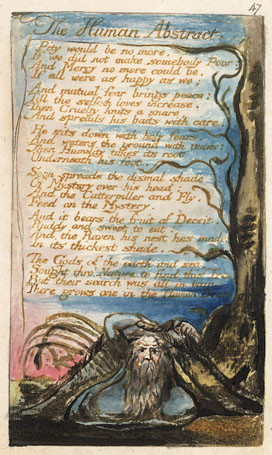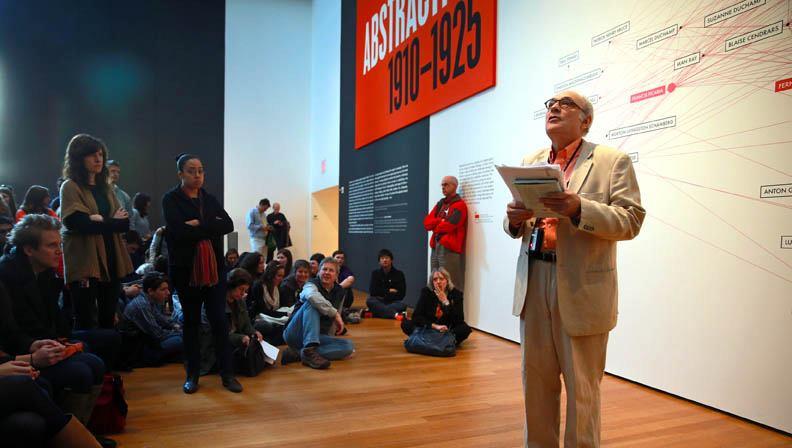
Disfiguring Abstraction: a performance at MoMA on April 3

Disfiguring Abstraction
 a performance at the Museum of Modern Art on April 3, 2013 at 12:30pm in the Inventing Abstraction show on the sixth floor of the museum, assembling under the Network Connections sign at the beginning of the exhibition. Part of the series Uncontested Spaces: Guerrilla Readings in Kenneth Goldsmith's "Poet Laureate" program. This reading is a supplement to "Disfiguring Abstraction," an essay on the Inventing Abstraction show forthcoming in the Spring 2013 issue of Critical Inquiry (which begins with these aphorisms and first paragraph):
a performance at the Museum of Modern Art on April 3, 2013 at 12:30pm in the Inventing Abstraction show on the sixth floor of the museum, assembling under the Network Connections sign at the beginning of the exhibition. Part of the series Uncontested Spaces: Guerrilla Readings in Kenneth Goldsmith's "Poet Laureate" program. This reading is a supplement to "Disfiguring Abstraction," an essay on the Inventing Abstraction show forthcoming in the Spring 2013 issue of Critical Inquiry (which begins with these aphorisms and first paragraph):
You can be a museum or you can be modern, but you can’t be both.
––Gertrude Stein to Alfred Barr
No painting is so figurative that under certain conditions it will not look abstract.
––after Oscar Wilde
What color is abstraction? It can’t just be white. Its invention in time (for example, 1910 or 1912) only means that it creates a holding space for abstractions from other times and places. To centrally locate one locus of abstraction would be to diminish the radicality of abstraction’s connections to its others – or its engendering of its others.
 "Disfiguring Abstraction"
"Disfiguring Abstraction"
DOI: 10.1086/670042
Critical Inquiry
Spring 2013, Vol. 39, No. 3: 486-497
published by the University of Chicago Press
•William Blake, “The Human Abstract” from Song of Experience (1794)
•Wallace Stevens, "Notes Toward a Supreme Fiction," preface and the first part, "It Must Be Abstract" (1942)
•Three short “sounds” works from Technicians of the Sacred: A Range of Poetries from Africa, America, Asia, Europe and Oceania, ed. Jerome Rothenberg (1968): Aboriginal, Shaker, Navaho
•William Carlos Williams, "The Great Figure" (1921)
•Gertrude Stein, Tender Buttons, in honor of the centennial of the work
____________“Arthur A. Grammar” (1931)
•Samuel Greenberg, “Spirituality” (1915)
•Elsa von Freytag Loringhoven, from Body Sweats: The Uncensored Writings, ed. Irene Gammel and Suzanne Zelazo (poems for the 1920s): "A Dozen Cocktails Please" (1927)
•Mina Loy, "Aphorisms of Futurism" (1914) & "Songs of Johannes" [“Love Songs”] (1915-1917) [link is to my 2009 MoMA performance]
•Nicolàs Guillén, "Sensemayá" (1934), tr. Langston Hughes
•"Unloading Rails" (MP3) called by Henry Truvillion at Wiergate, Texas, 1940.
•Vicente Huidobro "Altazor," canto VII (1931) -- my performance of this in Apri 2013
•Cab Calloway, "Minnie the Moocher" (1931), my adattion as "Abstraction the Moocher"

Part Two: Re-Inventing Abstraction (poems of artists/poets included in the Inventing Abstraction show)
Stéphane Mallarmé, “Salute” (1893), my adaption
Velimir Khelbnikov, “Incantation by Laughter” (1908-09) (my translation): my 2011 performance
F.T. Marinetti, "Futurist Manifeto" (1909) [link is to my 2009 MoMA performance] & "VIve La France" (1914-15 [parole en liberté]
Wassily Kandinsky, "Song" from Klänge (1912) (my adaption)
Blaise Cendrars, "Prose of the Transiberian” (1913) (tr .Ron Padgett)
Guillaume Apollinaire: “Le Pont Mirabeau” (1913) (my translation)
Alexei Khruchenik, Pomade (1913)
Francis Picabia, “Staircase” from I Am A Beautiful Monster: Poetry, Prose, and Provocation, tr. Mark Lowenthal
Kurt Schwitters, Ur Sonate (1922-1932)
James Joyce, Finnegans Wake (1922-1939)
Pablo Picasso, The Burial of the Count of Orgaz & Other Writings, ed. and tr. Jerome Rothenberg and Pierre Joris (1935-1959)
Marsden Hartley: “Indian Point” and "As the Buck Lay Dead" (prob. late 1930s or early 40s)
and of related interest:
•my conversation with Dominique Fourcade, "La poétique, l'écriture de la poésie et l'invention du modernism" (Poetics, the writing of poetry, and the invention of modernism) presentated at the Gertrude Stein and the Arts conference, which was part of the Matisse, Cézanne, Picasso... L’aventure des Stein at the Grand Palais in Paris.
•Sonia Delaunay and the rag trade
•"MoMA Mia" -- a conversation with Amit Chadhuri
The performance dedicated to the memory of Thomas McEvilley. Because of time limitations, only part of this program was performed. Note links to earlier MoMA performances of Loy and Marinetti.
photos © Lawrence Schwartzwald; may not be used without permission.